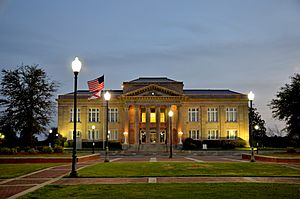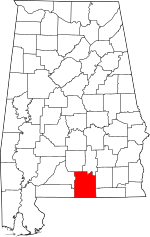Covington County, Alabama facts for kids
Quick facts for kids
Covington County
|
||
|---|---|---|

The Covington County Courthouse in Andalusia
|
||
|
||

Location within the U.S. state of Alabama
|
||
 Alabama's location within the U.S. |
||
| Country | ||
| State | ||
| Founded | December 17, 1821 | |
| Named for | Leonard Covington | |
| Seat | Andalusia | |
| Largest city | Andalusia | |
| Area | ||
| • Total | 1,044 sq mi (2,700 km2) | |
| • Land | 1,030 sq mi (2,700 km2) | |
| • Water | 13 sq mi (30 km2) 1.3% | |
| Population
(2020)
|
||
| • Total | 37,570 | |
| • Estimate
(2023)
|
37,952 |
|
| • Density | 35.987/sq mi (13.895/km2) | |
| Time zone | UTC−6 (Central) | |
| • Summer (DST) | UTC−5 (CDT) | |
| Congressional district | 2nd | |
|
||
Covington County is a place in the south-central part of Alabama, a state in the United States. It was briefly called Jones County. In 2020, about 37,570 people lived there. The main town and county seat is Andalusia. The county is named after Brigadier General Leonard Covington, a hero from the War of 1812.
Contents
History of Covington County
Covington County was officially created on December 17, 1821. For a short time, its name was changed to Jones County on August 6, 1868. But just two months later, on October 10, 1868, the original name, Covington County, was brought back.
This area has faced some tough weather. In September 1979, a big storm called Hurricane Frederic caused a lot of damage. The county was declared a disaster area. It happened again in October 1995, when Hurricane Opal hit the area.
Where is Covington County?
Covington County covers about 1,044 square miles. Most of this area, about 1,030 square miles, is land. The rest, about 13 square miles, is water. That means about 1.3% of the county is water.
The county is located in a flat area called the Gulf Coastal Plain. Two important rivers flow through the county: the Conecuh River and the Yellow River.
Main Roads
Many important roads help people travel through Covington County. These include:
 U.S. Highway 29
U.S. Highway 29 U.S. Highway 84
U.S. Highway 84 U.S. Highway 331
U.S. Highway 331 State Route 52
State Route 52 State Route 54
State Route 54 State Route 55
State Route 55 State Route 100
State Route 100 State Route 134
State Route 134 State Route 137
State Route 137
Local Transport
The Covington Area Transit System, also known as CATS, helps people get around. It offers a service where you can call and arrange for a ride when you need it.
Neighboring Counties
Covington County shares its borders with several other counties:
- To the north: Butler County and Crenshaw County
- To the east: Coffee County and Geneva County
- To the southeast: Walton County, Florida (in Florida)
- To the southwest: Okaloosa County, Florida (in Florida)
- To the west: Escambia County and Conecuh County
Protected Nature Areas
Part of the Conecuh National Forest is located within Covington County. This is a special area protected for nature and wildlife.
People of Covington County
| Historical population | |||
|---|---|---|---|
| Census | Pop. | %± | |
| 1830 | 1,522 | — | |
| 1840 | 2,435 | 60.0% | |
| 1850 | 3,645 | 49.7% | |
| 1860 | 6,469 | 77.5% | |
| 1870 | 4,868 | −24.7% | |
| 1880 | 5,639 | 15.8% | |
| 1890 | 7,536 | 33.6% | |
| 1900 | 15,346 | 103.6% | |
| 1910 | 32,124 | 109.3% | |
| 1920 | 38,103 | 18.6% | |
| 1930 | 41,356 | 8.5% | |
| 1940 | 42,417 | 2.6% | |
| 1950 | 40,373 | −4.8% | |
| 1960 | 35,631 | −11.7% | |
| 1970 | 34,079 | −4.4% | |
| 1980 | 36,850 | 8.1% | |
| 1990 | 36,478 | −1.0% | |
| 2000 | 37,631 | 3.2% | |
| 2010 | 37,765 | 0.4% | |
| 2020 | 37,570 | −0.5% | |
| 2023 (est.) | 37,952 | 0.5% | |
| U.S. Decennial Census 1790–1960 1900–1990 1990–2000 2010–2020 |
|||
According to the 2020 census, there were 37,570 people living in Covington County. There were 14,852 households and 9,924 families.
In 2010, the county had 37,765 people. About 22.6% of the people were under 18 years old. The average age was 42.4 years. For every 100 females, there were about 93.9 males.
Many people in Covington County have English roots, making up about 41.2% of the population in 2012. Another 16.0% said they had "American" ancestry. About 14.5% of the people reported having Irish family backgrounds.
Towns and Cities
Covington County has several towns and cities where people live.
Cities
Towns
Small Communities
There are also many smaller, unincorporated communities in the county. These are places that don't have their own local government.
See also
 In Spanish: Condado de Covington (Alabama) para niños
In Spanish: Condado de Covington (Alabama) para niños


